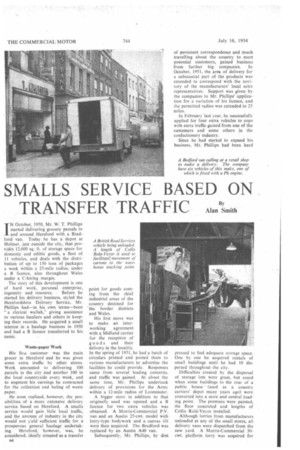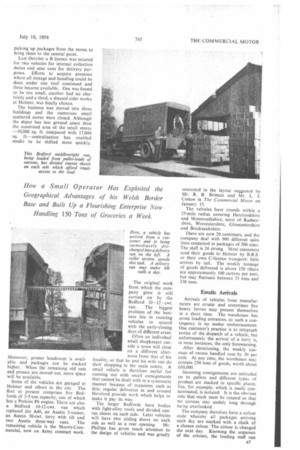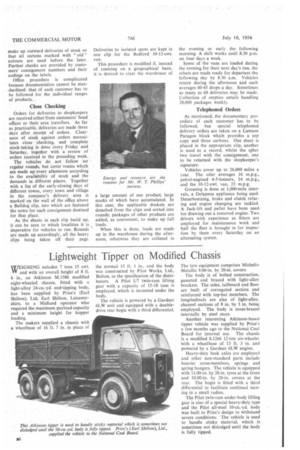SMALLS SERVICE BASED ON TRANSFER TRAFFIC
Page 38

Page 39

Page 40

If you've noticed an error in this article please click here to report it so we can fix it.
IN October, 1950, Mr. W. T. Phillips started delivering grocery parcels in and around Hereford with a Bradford van. Today he has a. depot at Holmer, just outside the city, that provides 12.000 sq. ft. of storage space for domestic and edible goods, a fleet of 11 vehicles, and deals with the distribution of up to 150 tons of Packages a week within a 25-mile radius, under a Et licence, also throughout Wales under a C-hiring margin.
The story of this development is one of hard work, personal enterprise, ingenuity and resource. , Before he started his delivery business, styled the Herefordshire Delivery Service, Mr. Phillips had—in his own terms—been
a clerical wallah," giving assistance to various hauliers and others in keeping their records. He acquired a small interest in a haulage business in 1950 and had a B licence transferred to his name.
Waste-paper Work
His first customer was the main grocer in Hereford and he was given some extra traffic by other stores. Work amounted to delivering 100 parcels in the city and another 100 in the local countryside every week, and to augment his earnings he contracted for the collection and bating of waste paper.
He soon realized, however, the possibilities of a more extensive delivery service based on Hereford. A smalls service would gain little local traffic, and the amount of industry in the city would not yield sufficient traffic for a prosperous general haulage undertaking. Hereford, however, was, he considered, ideally situated as a transfer
n4 point for goods coming from the chief industrial areas of the country destined for the border districts and Wales.
His first move was to make an interworking agreement with a Midland carrier for the reception of goods and their delivery in the locality. In the spring of 1951, he had a batch of circulars printed and posted them to various manufacturers to advertise the facilities he could provide. Responses came from several leading concerns, and traffic was gained. At about the same time, Mr. Phillips undertook delivery of provisions for the Army within a 12-mile radius of Leominster.
A bigger store in addition to that originally used was opened and a B licence for two extra vehicles was obtained. A Morris-Commercial P.V. van and an Austin 25-cwt. model with lorry-type bodywork and a canvas tilt were then acquired. The Bradford was replaced by an Austin A40 van.
Subsequently, Mr. Phillips, by dint pressed to find adequate storage space. One by one he acquired rentals of small buildings until he had 10 dispersed throughout the city.
Difficulties created by the dispersal of storage lots were great, but eased when some buildings to the rear of a public house (used as a country carriers' depot many years ago) were converted into a store and central loading point. The premises were painted, the floor concreted and lengths of Collis Rola-Veyor installed.
Although lorries from manufacturers unloaded at any of the small stores, all delivery vans were dispatched from the new yard. A Morris-Commercial 30cwt. platform lorry was acquired for Moreover, greater headroom is available and packages can be stacked higher. When the remaining old vats and presses are moved out, more space will be available.
Some of the vehicles are garaged at Holmer and others in the city. The fleet at present comprises five Bedfords of 2-5-ton capacity, one of which has a Perkins P6 engine. There are also a Bedford 10-12-cwt. van which replaced the A40, an Austin 3-tonner, an Austin 30-cwt. lorry with tilt and two Austin three-way vans. The remaining vehicle is the Morris-Commercial, now on Army contract work. The original work from which the company grew is still carried on by the Bedford 10 12 cwt. van. The biggest problem of the business lies in routeing vehicles to accord with the early-closing days of different areas.
Often an individual small shopkeeper outside a town will close on a different afternoon from that of his locality, so that he and his wife can do their shopping in the main centre. A small vehicle is therefore useful for running out with small consignments that cannot be dealt with in a systematic manner because of occasions such as this; regular deliveries in and around Hereford provide work which helps to make it pay its way.
The larger Bedfords have bodies with light-alloy roofs and divided canvas sheets on each side. Later vehicles will have two sliding doors on each side as well as a rear opening. Mr. Phillips has given much attention to the design of vehicles and was greatly interested in the layout suggested by Mr. R. B. Brittain and Mr. L. J. Cotton in The Commercial Motor on January 15.
The vehicles have rounds within a 25-mile radius covering Herefordshire and Monmouthshire, most of Radnorshire, Worcestershire, Gloucestershire and Brecknockshire.
There are now 20 customers, and the company deal with 900 different sales lines contained in packages of 500 sizes. The staff is 24 strong. Most customers send their goods to Holmer by B.R.S. or their own C-licence transport: little arrives by rail. The weekly tonnage of goods delivered is about 150 (there are approximately 100 cartons per ton), but may fluctuate between 55 tons and 230 tons.
Erratic Arrivals
Arrivals of vehicles from manufacturers are erratic and sometimes five heavy lorries may present themselves in a short time. The warehouse has seven loading entrances, so such a contingency is no undue embarrassment. One customer's practice is to telegraph notice of the dispatch of a vehicle, but unfortunately the arrival of a lorry is, in most instances, the only forewarning.
After derationing, the weekly tonnage of sweets handled rose by 50 per cent. At any time, the warehouse may contain 250 tons of goods, worth about £60,000.
Incoming consignments are unloaded on to pallets and different types of product are stacked in specific places. Tea, for example, which is easily contaminated, is isolated. It is the obvious rule that stock must be rotated so that no cartons stay unduly long through be:ng overlooked.
The company therefore have a colour code whereby all packages arriving each day are marked with a chalk of a chosen colour. The colour is changed the next day. Knowing the sequence of the colours, the loading staff can
make up outward deliveries of stock so that all cartons marked with "old" colours are used before the later. Further checks are provided by customers' consignment numbers and their codings on the labels.
Office procedure is complicated because documentation cannot be stan. dardized: that of each customer has to be followed for the individual ranges of products.
Close Checking
Orders for deliveries to shopkeepers are received either from customers' head offices or their area travellers. As far as practicable, deliveries are made three days after receipt of orders. Clearance of stock against orders necessitates close checking,, and complete stock-taking is done every Friday and Saturday, together with a review of orders received in the preceding week.
The vehicles do not follow set regular rounds, but cover routes which are made up every afternoon accgrding to the availability of stock and the demands in different places. Together with a list of the early-closing days of different towns, every town and village in the company's delivery area is marked on the wall of the office above a Bulldog clip, into which are fastened the notes for each consignment destined for that place.
As the sheets in each clip build up, it can be seen to which localities it is imperative for vehicles to run. Rounds are made up accordingly, all the heavy clips being taken off their pegs.
a large amount of one product, large stocks of which have accumulated. In this case, the applicable dockets are detached from the clips and sorted into rounds; packages of other products are added, as convenient, to make up full loads.
When this is done, loads are made up in the warehouse during the afternoon, otherwise they are collated in the evening or early the following morning. A shift works until 8.30 p.m. on four days a week.
Some of the vans are loaded during the evening for their next day's run, the others are made ready for departure the following day by 8.30 a.m. Vehicles return during the afternoon and each averages 40-45 drops a day. Sometimes as many as 60 deliveries may be made. Collection of empties entails handling 20,000 packages weekly.
Telephoned Orders
As mentioned, the documentary procedure of each customer has to be followed, but special telephoned delivery orders are taken on a Lamson Paragon block which provides a top copy and three carbons. One sheet is placed in the appropriate clip, another is used as a record, whilst the gther two travel with the consignment, one to be returned with the shopkeeper's signature.
Vehicles cover up to 26,000 miles a year. The oiler averages 16 rn.p.g., petrol-engined 4-5-tonners, 14 m.p.g., and the 10-12-cwt. van, 23 m.p.g.
Greasing is done at 1,000-mile intervals, a Delapena appliance being used. Decarbonizing, brake and clutch refacing and engine changing are tackled. A Jack-lift and pallet have been used for drawing out a removed engine. Two, drivers with experience as fitters are employed for maintenance work and half the fleet is brought in for inspection by them every Saturday on an alternating system.




























































































